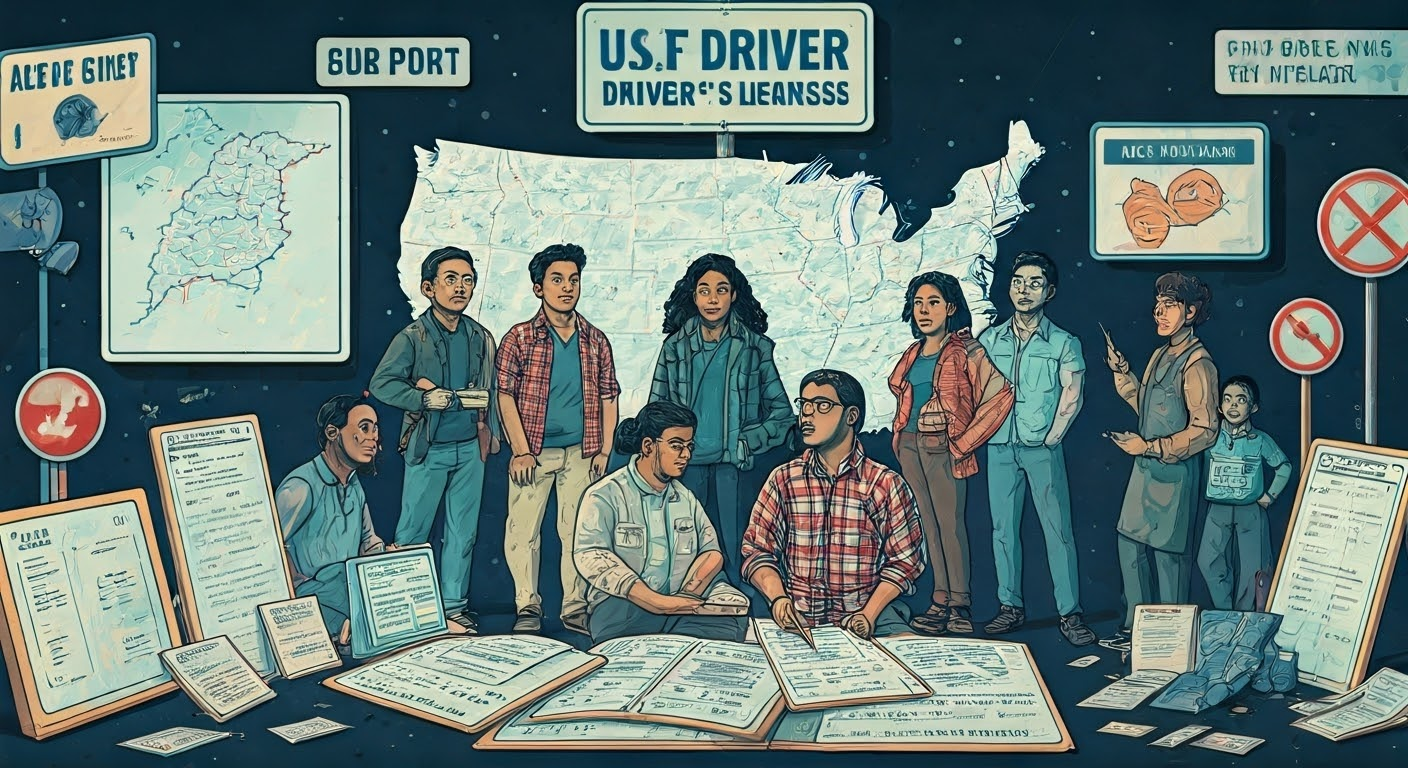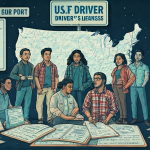The process of obtaining a driver’s license in the United States as a foreigner involves navigating state-specific requirements, documentation verification, and testing procedures. While US driving laws generally allow foreigners to drive with valid home country licenses for up to a year in most states, those planning longer stays need to obtain a US license. This report outlines the eligibility criteria, documentation requirements, testing procedures, state-specific variations, and special considerations for different groups of foreign nationals seeking to obtain a US driver’s license.
Eligibility and General Requirements
Understanding Legal Driving Status for Foreigners
The United States allows foreigners to drive with a valid home country license for up to a year in most states, providing temporary driving privileges to visitors and new arrivals1. However, individuals planning extended stays should note that an International Driving Permit (IDP) may be required in addition to their foreign driver’s license in many states1. This document serves as an official translation of your license and is recognized across the country, facilitating the transition period before obtaining a US license1.
Basic Eligibility Criteria
To qualify for a US driver’s license, foreign nationals typically need to be at least 18 years old and possess a valid driver’s license from their home country1. The age requirement ensures consistency with US driving standards, while the existing license demonstrates prior driving experience and knowledge. Additionally, applicants must have legal status in the United States through a valid visa or green card, which establishes their right to remain in the country during the license validity period1.
Documentation Requirements
Foreign nationals must provide comprehensive documentation when applying for a US driver’s license. This typically includes proof of identity (such as a passport), evidence of legal presence in the US (visa or green card), proof of residency in the specific state (utility bills or lease agreements), and a Social Security Number when applicable1. These requirements ensure that licenses are issued only to individuals legally residing in the state and country, maintaining the integrity of the identification system1.
Essential Documentation for License Application
Valid Visa and Immigration Status Verification
When applying for a US driver’s license, demonstrating legal presence in the country is paramount. A valid visa that corresponds to your purpose of stay, whether it’s a student visa, work visa, or another category, serves as the primary evidence of legal entry and permission to remain in the United States1. DMV officials will carefully scrutinize this documentation to verify authenticity and current validity before proceeding with your application1.
Beyond the visa itself, maintaining proper immigration status documentation is essential. Non-US citizens should prepare current and accurate records, potentially including I-94 forms, visa stamps, and other immigration authority verification documents1. Organizing these materials methodically creates a comprehensive proof of legal presence that facilitates interaction with DMV personnel and expedites the application process1.
Establishing State Residency
A US driver’s license functions both as driving authorization and as a valid photo identification in numerous contexts, necessitating proof that you reside within the state where you’re applying1. The DMV typically requires multiple documents confirming your address, with utility bills (gas, electricity, water) bearing your name and address serving as primary evidence1. Lease agreements, mortgage statements, bank statements, and credit card bills addressed to your residence can also substantiate your claim of residency1.
State DMVs often request several complementary residency documents to strengthen your application, creating a comprehensive profile that confirms your living situation1. Understanding the specific residency documentation requirements for your state before visiting the DMV can significantly streamline the application process and prevent unnecessary delays1.
Identity and Birth Date Verification
Proving identity is a critical component of the driver’s license application process, particularly for foreign nationals1. Original documents, rather than photocopies, are mandatory as DMV officials must verify their authenticity during the application review1. A valid passport typically serves as the primary identification document, simultaneously confirming identity, nationality, and legal entry into the United States—essential verification points for non-citizens1.
Supplementary identification documents, such as birth certificates or national identification cards from your home country, may be requested to provide additional verification1. Ensuring consistency across all documentation is crucial; even minor discrepancies in name spelling, birth dates, or other personal details can cause delays or complications in the application process1. Meticulous attention to documentation accuracy helps facilitate smoother processing and approval1.
Knowledge and Skills Testing Requirements
Written Test Preparation
Obtaining a US driver’s license requires demonstrating proficiency in understanding traffic laws and road safety principles through a written knowledge test1. This examination evaluates comprehension of traffic regulations, road signage interpretation, and safe driving practices as outlined in the state’s driver manual1. Foreign applicants should thoroughly study this state-specific resource before attempting the test, as traffic laws and signage may differ significantly from their home countries1.
Driving Test Requirements
The practical driving test assesses how effectively applicants implement theoretical knowledge in real-world driving situations1. Examiners evaluate performance on various maneuvers including parking techniques, lane changes, and intersection navigation1. Familiarizing yourself with local driving conditions and regulations is highly recommended, and many foreign applicants benefit from taking lessons with certified instructors who understand the specific requirements of the state’s driving test1.
Both written and practical examinations apply uniformly to all applicants regardless of nationality, ensuring consistent safety standards across the driving population1. Thorough preparation and understanding of expectations significantly increase the likelihood of success during these evaluations1.
State-Specific Driving License Procedures
Understanding State Variations
The United States comprises 50 distinct states, each with sovereign authority over driver licensing within its borders1. While fundamental driving rules remain relatively consistent nationwide, the specific requirements for obtaining a license can vary dramatically between states for foreign nationals1. These variations extend to documentation requirements, fee structures, and the difficulty level of written and practical examinations1.
Given these inconsistencies, relying on anecdotal information from acquaintances licensed in different states can lead to confusion and application delays1. Instead, consulting the official DMV website for your specific state provides the most accurate and current information regarding license requirements and procedures1.
California Driver’s License Process
For foreign nationals relocating to California, the process of obtaining a driver’s license involves several structured steps1. Initially, applicants must gather essential documentation including proof of identity, legal presence in the US, and California residency1. Once documentation is complete, scheduling an appointment with the local DMV office is recommended, as appointment-based visits typically involve shorter wait times than walk-in service1.
During the DMV appointment, applicants present their documentation and complete several testing requirements, including a vision screening, written knowledge test, and potentially a behind-the-wheel driving examination1. Upon successful completion of these steps and payment of applicable fees, the California driver’s license is processed and mailed to the applicant’s registered address, enabling them to legally navigate throughout the diverse Golden State1.
New York Driver’s License Process
Navigating the New York DMV system as a foreign applicant involves specific procedural requirements1. The process begins with assembling necessary documentation including your foreign driver’s license, passport, visa or green card details, Social Security Number (if applicable), and proof of New York residency1. While scheduling an appointment is advisable to minimize wait times, many DMV offices also accommodate walk-in applicants1.
Foreign applicants should note that the New York DMV typically retains foreign driver’s licenses during the application process and may not return them upon issuance of a New York license1. After document verification, applicants generally must complete vision screening, written knowledge assessment, and road testing, though certain tests may be waived based on reciprocity agreements with specific countries1. Following successful completion of all requirements and fee payment, applicants receive their New York driver’s license1.
Texas Driver’s License Process
Texas, known for its expansive landscapes and automotive culture, offers a straightforward licensing process for foreign nationals through the Department of Public Safety (DPS)1. Initial preparation involves gathering required documentation, including passport, visa or green card information, Texas residency proof, and Social Security Number if available1. Presenting an International Driving Permit alongside other documentation can expedite processing1.
After securing an appointment at a local DPS office, applicants typically undergo vision testing, fingerprinting, and submission of their international driving credentials1. Written and practical testing requirements vary based on reciprocity agreements with the applicant’s home country1. Upon completing the necessary steps and paying required fees, successful applicants receive a temporary license followed by a permanent credential mailed to their registered Texas address1.
Florida Driver’s License Process
The Florida Department of Highway Safety and Motor Vehicles (DHSMV) administers driver licensing for foreign nationals relocating to the Sunshine State1. Applicants must provide comprehensive documentation including proof of identity (typically a passport), Social Security Number information, evidence of legal US presence, and two documents confirming Florida residency1. Preparing complete documentation before visiting a DHSMV office streamlines the application process1.
Florida mandates that all driver’s license applicants, including those with foreign licenses, complete a vision screening and written knowledge examination covering state traffic laws and safe driving practices1. The DHSMV website offers study materials to help applicants prepare for these assessments1. Additionally, a practical driving examination with a DHSMV evaluator is required to demonstrate on-road competency1. Scheduling an appointment online before visiting a service center can reduce wait times substantially1.
Applying and Testing Process
Navigating the Application Process
The practical process of obtaining a US driver’s license begins with locating the appropriate Department of Motor Vehicles (DMV) office in your area1. Many DMV offices operate by appointment, though some accept walk-in applicants, making it important to verify the preferred method for your local office1. During your visit, you’ll submit your documentation package, pay the required application fees, and likely complete an initial vision screening to ensure your eyesight meets minimum driving standards1.
Depending on your state of residence and the type of foreign driver’s license you possess, you may need to complete both knowledge and skills assessments1. The written test evaluates your understanding of US traffic laws, while the driving examination assesses your practical ability to safely operate a vehicle according to local standards1. Familiarizing yourself with state-specific traffic regulations and practicing common driving maneuvers significantly improves your chances of successfully completing these requirements on the first attempt1.
Special Considerations for Specific Groups
International Students and Exchange Visitors
International students pursuing education in the United States face unique challenges when applying for driver’s licenses1. The process requires navigating requirements that align with their student visa status and demonstrating both legal presence and appropriate residency documentation1. Many international students encounter complications related to Social Security Numbers (SSNs), particularly those whose visa categories don’t permit employment1.
Students ineligible for SSNs should obtain an official letter from the Social Security Administration confirming this ineligibility, as this documentation is typically accepted by DMV offices in lieu of an actual SSN1. Additionally, international students need to present their I-20 form and enrollment verification from their educational institution1. Consulting with the Designated School Official (DSO) or international student office before visiting the DMV can provide valuable guidance on state-specific requirements and documentation preparation1.
Undocumented Immigrants and DACA Recipients
The process of obtaining driver’s licenses for undocumented immigrants and DACA (Deferred Action for Childhood Arrivals) recipients varies significantly across states, with some jurisdictions offering special licenses or driving privilege cards for these populations1. DACA recipients often face fewer obstacles, as they can present their Employment Authorization Document (EAD) as proof of legal presence, along with identity verification and state residency documentation1.
Requirements may include demonstrating educational enrollment or employment status in addition to standard identification and residency verification1. Given the complex and evolving nature of these regulations, seeking guidance from immigrant advocacy organizations can provide valuable insights into state-specific requirements, common application pitfalls, and available support services1.
Military Personnel and Their Families
Foreign military members stationed in the United States and their dependents typically benefit from streamlined driver’s licensing procedures, reflecting the cooperative relationship between the US government and military organizations1. The simplified process generally requires presentation of a valid foreign driver’s license, military orders documentation, dependent identification cards if applicable, and proof of US residency1.
Conclusion
Obtaining a US driver’s license as a foreigner involves navigating a complex system of federal immigration requirements and state-specific licensing procedures. While the process varies significantly between states, understanding the fundamental documentation requirements, testing expectations, and special considerations for different population groups can help foreign nationals successfully acquire driving privileges in the United States. By thoroughly researching state-specific requirements, preparing appropriate documentation, and adequately studying for required examinations, foreign nationals can navigate the licensing process efficiently and gain the mobility benefits that come with legal driving authorization in the United States.
Prospective applicants should consult their state’s Department of Motor Vehicles website for the most current and specific information regarding license requirements, as regulations may change over time. Additionally, international students, temporary workers, and other visa holders should consider how their immigration status might affect their eligibility and documentation requirements when applying for a US driver’s license.
I am a student of DUT University. I have been involve in WP Development. I also write content as a profession.




